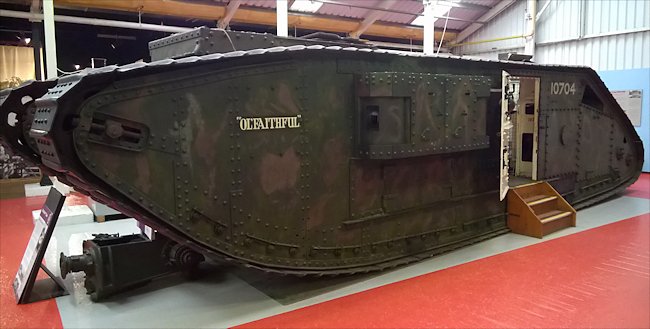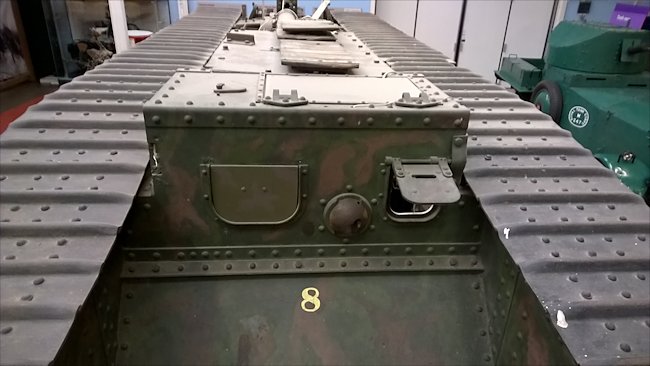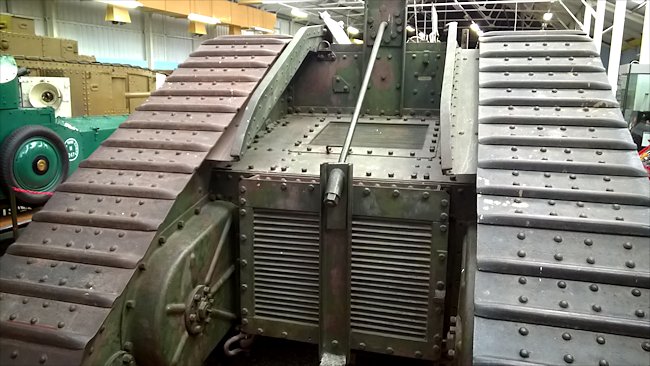Mark V** Female Tank
This WW1 British Mark V** Female tank can be found at the Tank Museum, Bovington, Dorest, BH20 6JG, England. Their website is tankmuseum.org.

WW1 British Mark V** Female Tank
The British Mark V** Female Tank was a stretched version of the standard Mark V tank. In an effort to counter the effects of the tank the Germans constructed wider trenches and in response to this the British built longer tanks.
The Mark V*, a stretched version of the Mark V, saw service in 1918 but was not entirely successful. The Mark V** Tank was an improved even longer model which performed a lot better but it was not completed in time to take part in the war.
The British Mark IV tank had increased armour and had its fuel tanks repositioned to the rear of the vehicle to try and improve survivability. These features were included on the standard length Mark V female tank, which had been adapted to attack the German Hindenburg line.
Mark V female tanks weighed in at 28 tons and included side hatches. Thanks to a new steering system, it was the first British tank that could be driven by one man. It was designed in 1917, but did not see active service on the battlefield until 1918 during the last months of the war. Around 400 Mark V tanks were built. The Mark V** weighed 34 tonnes

WW1 British Mark V** Female Tank's Commander and Drivers Portholes
Unlike the German A7V tank that required 18 crew members, this British tank only required a crew of eight. The commander, driver and six gunners. It only had a top speed of 4.6 mph (7.4 km/h) and had a range of 45 miles. The female tanks were armed with six .303 inch Hotchkiss Mk1 machine guns, two on each side, one at the front and one at the rear.
Machine gun only standard length Mark V female tanks took part in eight major attacks before the end of the war. Two female tanks would normally support one male tank. The first saw action on 4 July 1918 during the battle of Hamel. A group of 60 tanks assisted Australian infantry to breakthrough the German lines.

WW1 British Mark V** Female Tank
Post war changes
On the Mark V** the driver's cab was enlarged, although it was later cut down on this particular tank, and the engine was uprated to improve performance. This tank was nicknamed Ol' Faithful, was modified by the Experimental Bridging Establishment (EBE) at Christchurch near Bournemouth.
The EBE had been established to investigate how tanks could be adapted to undertake Royal Engineer tasks and to this end it was equipped with a jib at the front, operated by a hydraulic pump driven off the engine. Thus equipped the tank could undertake the following tasks:
It could carry and lay a 20 foot tank bridge
It could trail a roller from the jib to explode mines
It could place and detonate demolition charges
It could push and launch a large portable bridge
It could act as an ordinary crane.
Tanks fitted with this equipment took part in the 1919 Royal Tournament but the experiment was discontinued soon afterwards and the ideas all had to be invented again in the next war.
Where can I find other preserved Mark V Female Tanks?
- Arkhangelsk, Arkhangelsk Oblast, Russia
WW1 tank books
